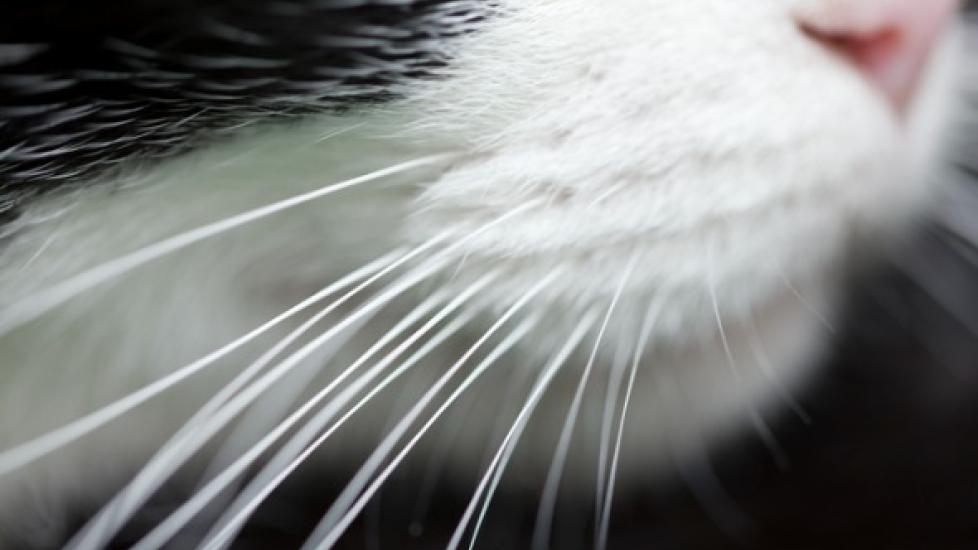Why Do Cats Have Whiskers?
Straight or curly, long or short, whiskers are a notable part of the feline face. Most would agree that a cat without whiskers would be a strange sight indeed, but it may surprise you how important these seemingly superficial structures are to your cat!
A cat’s whiskers are integral to how they interact with their environment, and they serve a variety of functions. Let’s take a look at why cats have whiskers and how they use them.
What Do Cat Whiskers Do?
Cat whiskers do some pretty amazing things. Here are some of the ways cats use their whiskers.
Sense of Touch
The main function of cat whiskers is the sense of touch. The follicles that these hairs grow from are surrounded by sensory cells. These cells transmit tactile information that’s similar to the signals our fingertips send to our brains.
The sensory cells are stimulated by the smallest vibrations in the hair, allowing cats to feel not only solid objects that they brush against but even to notice air currents from movement nearby.
This helps our mostly farsighted felines to:
-
Better evaluate their environment up close
-
Avoid threats to their eyes and face, like branches and insects
-
Hunt better at night
-
Be able to judge whether they can fit through small spaces
Sense of Orientation
Some whisker follicle cells also have proprioceptive ability, meaning that the way gravity pulls on the hair will tell a cat how they are oriented in relation to the ground. That’s very important for an animal who is always supposed to land on their feet!
Communication
Finally, there is evidence to suggest that cat whiskers may be involved in communicating with other cats and even observant owners. Tiny muscles around the base of the whiskers allow stressed cats to point their whiskers toward potential threats and relax them when they are content. A cat who doesn’t feel well may pull their whiskers back against their face in a grimace.
How Many Whiskers Do Cats Have?
Though it may be hard to tell with some cats, whiskers are very regularly spaced and grow in very specific locations. The most prominent whiskers, those on the upper lip, are in ordered rows of 4-5 with the shorter whiskers in front and longer whiskers in back.
Most cats have around 12 whiskers on each upper lip, 3 over each eye, and a few shorter ones on their chin. If you look carefully, you will notice that most cats also have a few whiskers on the back of their wrists!
Can Cats Injure Their Whiskers?
Though cat whiskers transmit sensory information, the hair itself is made of keratin, just like the hairs on your head, and they do not have feeling.
That said, each cat whisker follicle can be associated with as many as 100-200 neurons, and overstimulation of the whisker, or “whisker fatigue,” is a real issue. Whisker fatigue is usually caused by chronic, recurrent pressure on the whisker and firing of the neurons in a way that overstimulates your cat. It is often associated with inappropriately sized food and water dishes.
If you notice that your cat dislikes eating from their food bowl or seems distressed until they scoop it out onto the floor, mention this to your veterinarian. Your cat may benefit from some shallower dishes to protect their sensitive whiskers.
Diseases that can affect the haircoat, such as infection, mange, and vasculitis, can also affect cat whisker follicles and make them fall out or delay their growth.
In addition, some medications, like chemotherapy drugs, can make a cat lose their whiskers. As always, be sure to ask your veterinarian if you have concerns about the health of these important structures.
What Happens If You Cut Cat Whiskers?
Since the nerves are associated with the follicle and not the hair itself, cutting a cat’s whiskers is not painful in and of itself, but you should not do this. Even indoor kitties rely on the sensory input from their whiskers, and a sudden change in the information they can get from their environment can be very stressful and confusing.
Do Cat Whiskers Grow Back?
If your cat does break their whiskers, or they have to be trimmed for medical reasons, as long as the follicle does not suffer any damage, these hairs will grow back. In fact, normal cat whiskers are occasionally shed just like other hairs, though never more than 1-2 at a time.
It can take between 6 weeks and 3 months for a cat’s facial whisker to grow back to the appropriate length to be functional. It is very normal with some coat colors for white whiskers to grow back as black, or vice versa. The color change will not affect their function.
Featured Image: iStock.com/percds
